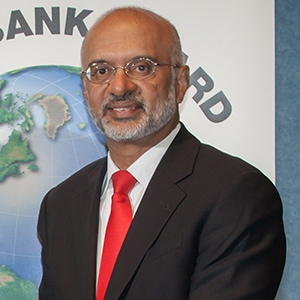Piyush Gupta, CEO of DBS talks about the value in being a trusted brand, the benefits of developing technology in-house, and why Singapore makes a great home base.

Global Finance: Does being the Safest Bank in Asia and a trusted brand give DBS leeway to be more innovative than its peers?
Piyush Gupta: Being safe and trusted are definitely important factors. The key drivers for “safety” include having a strong capital base and robust earnings power. Such financial strength is equally important to seed the investment needed for digital transformation. Over the last few years, our tech investment has amounted to some SGD 1 billion annually. We’ve been able to make significant investments while delivering record earnings because of the strength of our franchise. Our earnings power has been significantly enhanced in recent years through the development of several franchises, including wealth management, cash management and debt capital markets.
Having the trust of our customers and regulators is extremely useful as well; regulators are more willing to listen to ideas when they have confidence in the overall business systems of the institution, and customers are more willing to participate in pilots and experiments.
GF: Why is it important for banks to develop and control their own technology?
Gupta: We believe that in today’s world, business is technology and technology is business. This means that technology needs to be core competence, not just one other service that can be externally obtained. Owning technology capability results in greater speed, flexibility and lower costs. It also allows technology to be a partner in driving the business, as opposed to a “back office” function which is purely a delivery platform.
In 2009, our technology, hardware, data centers, network management and app development were fundamentally outsourced. At the end of 2017, we were 85% insourced. At the same time, we moved from legacy technology—big mainframes in large data centers—to cloud-enabled technology. By the end of 2017, 66% of our applications were cloud-ready. Leveraging cloud-enabled technology, coupled with increased usage of microservices and open source applications, has enabled us to reduce structural infrastructure costs, and at the same time improve resiliency and nimbleness.
GF: How do DBS’s Singapore roots and infrastructure impact the bank’s excellence?
Gupta: DBS has benefitted greatly from our Singapore roots. Singapore has a Smart Nation agenda, which involves using networks, data and infocomm technologies to improve living, health, mobility and services. The government has also taken huge strides to reinvent Singapore as Asia’s fintech hub.
Between the Monetary Authority of Singapore’s (MAS) regulatory sandbox, the Infocomm Development Authority putting money into fintech startups, and several other grants being made available, there is a lot of experimentation. As a small city-state, Singapore can also uniquely involve the public sector. In fact, DBS is part of a number of groundbreaking national projects. Operating in a nation with a very progressive government and regulator has been a huge boost to our ambitions to become a leader in digital banking and Best Bank in the World. The MAS’ sound, prudential regulations have also been key to Singapore banks being among the safest in the world.
GF: Do you see Southeast Asia becoming more regionally integrated?
Gupta: Southeast Asia sits at the heart of global supply chains, so China-US trade tensions will have an impact on the region. It’s hard to say how far-reaching the impact will be, especially when one takes into account the knock-on effects on sentiment and business confidence.
GF: How has digitization helped DBS’s small- and medium-sized enterprise (SME) business grow?
Gupta: In the same way that banking is being disrupted, many of our SME customers are in industries that are being disrupted. Our API platform has allowed us to provide SMEs solutions at an affordable cost, that would typically only be available to large corporations. The bank has also been proactive in trying to help our SME clients grow through the DBS BusinessClass social platform, which runs industry disruption events across our Asian network. In addition, our TechMatch program matches customers with suitable partners and even potential acquisition targets. Our SME bankers also run an SME Academy, which gives foundation classes to help entrepreneurs get started.
Underlining the success of DBS’ digitization effort, in 2017, digital customers made up 42% of our consumer and SME customer base in Singapore and Hong Kong but accounted for 63% of total income and 72% of profit before allowances.
Apart from digitization, we also offer a suite of other services to SMEs that are sometimes only available to bigger corporates. SMEs are the backbone of the global and regional economy, and with the center of economic gravity having shifted to Asia, we believe some Asian SMEs of today will be the multinationals of tomorrow.



